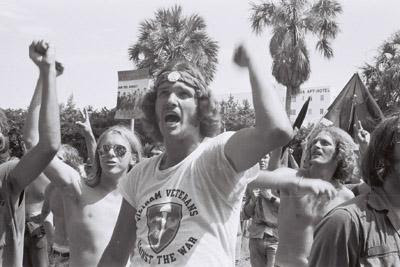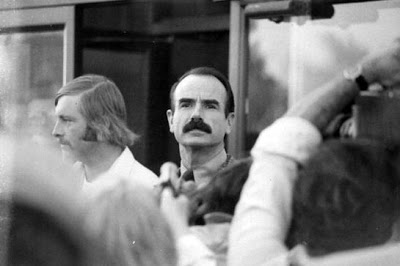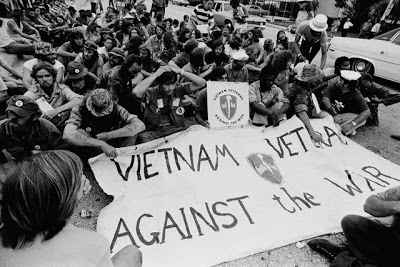Idiots and blinders:
Military ‘intelligence’ then and now
There is nothing new about such blindness to alternative possibilities. Forty years ago those of us who wanted to end the Vietnam War were the ‘terrorists.’
By Nancy Miller Saunders / The Rag Blog / September 6, 2011
Are the developers of our intelligence operations idiot savants, brilliant in some areas and totally oblivious in others? (Think Dustin Hoffman in The Rain Man.) Or do they wear blinders to keep themselves from seeing anything other than what they expect to see?
Recently I learned that our military is “forging the onscreen cyber-trademarks used by Al Qaeda” to post “confusing and contradictory orders, some so virulent that young Muslims dabbling in jihadist philosophy, but on the fence about it, might be driven away.”[1]
Did anyone at the Pentagon think about all those jihadists who are not on the fence who might follow those “virulent” (i.e., venomous, contagious; deadly, noxious; poisonous, hateful)[2] orders? Tom Engelhardt did. In a recent Tomgram he asks in his title, “Could the Pentagon Be Responsible for Your Death?”[3] Scary thought.
Engelhardt compared this plan to the Bureau of Alcohol, Tobacco, Firearms and Explosive’s (ATF) Operation Fast and Furious, which is either “an ambitious new strategy allowing Fast and Furious agents to follow the paths of guns from illegal buyers known as ‘straw purchasers’ through middlemen and into the hierarchy of the powerful Sinaloa drug cartel.”[4] Or, as the National Rifle Association (NRA) contends, it is a scheme to use ”the violence in Mexico as an excuse to promote gun restrictions.”[5]
Whatever the reason, according to the Washington Post, in the nearly two years of operation, more than 2,000 weapons (including AK47s) have been allowed to “walk” into Mexico. A U.S. Border Patrol agent was killed with one and fewer than 600 have been recovered.
There is nothing new about such blindness to alternative possibilities. Forty years ago those of us who wanted (among other things) to end the Vietnam War were the “terrorists.” The handful of Weather Underground bombers and a few other crazies got all of us branded as dangerous criminals. People worried that there would be even more serious riots at the 1972 national conventions than there had been at the Democrats’ 1968 convention in Chicago.
The RAND corporation did a contingency study of different ways the government could handle riots. These included declaring martial law, round-ups of activists, and even possibly canceling the election. News of these contingency plans made it into the news briefly.
Groups planning to demonstrate were making their own contingency plans to avoid rioting. Many provided training in passive resistance and asked the Vietnam Veterans Against the War (VVAW), to provide internal security. They were combat veterans who understood violence, wanted no more of it, knew how to defuse it, and how to exert the necessary authority. And VVAW had a consistent record of nonviolent protests.
Capitalizing on fears of rioting, certain myopic officials within the federal government thought up a way to put riots to good use — not unlike current ideas of aping al Qaeda to discourage jihadists and facilitating gunrunning to trace guns.
The Nixon administration put G. Gordon Liddy in charge of its convention plans. He obligingly developed his Gemstones, several “operations” named for gems and minerals, which he presented to Attorney General John Mitchell in the presence of White House counsel John W. Dean, III, and interim director of the Committee to Re-elect the President (CREEP) Jeb Stuart Magruder.[6]
Liddy later wrote that, Operation “DIAMOND was our counterdemonstration plan.” Calling demonstrations attacks, he wrote that he and his operatives would identify demonstration “leaders through intelligence before the attack got under way [his emphasis], kidnap them, drug them, and hold them in Mexico until after the convention was over… Leaderless, the attack would be further disrupted by fake assembly orders and messages, and if it ever did get off the ground it would be much easier to repel.”[7]
Magruder later described what he called an “awkward exchange” with his wife when he told her,
“[W]e may have to grab some of the radical leaders and take them to Mexico.”
“How would they get back?” Gail asked incredulously.
“They might not get back,” I said.[8]
Los Angeles police and FBI informer, Lewis Tackwood, added twists to the plot.
The plans entailed planting a number of agents-provocateur inside and outside the 1972 Republican Convention in San Diego… to provoke street battles with the police surrounding the convention hall, meanwhile agents inside the convention hall were to have planted explosives.
The intent…
…was to create a nation-wide hysteria that would then provide President Richard M. Nixon with the popular support necessary to declare a state of emergency; the government could then arrest all “radicals,” “militants,” and “left-wing revolutionaries.”[9]
Of all the perceived “terrorists,” Vietnam veterans were generally thought to be the most dangerous. They had the capability to launch attacks. They were popularly considered to be “baby burners.” The worst of all were veterans who denounced the war. They were traitors. They had to go. So VVAW was targeted. And I had a ringside seat.[10]
When 1972 began I was living with VVAW’s South-Central coordinator, Don Donner, at the University of Arkansas in Fayetteville. One of the local veterans, Bill Lemmer, insisted to me that the RAND study was not a contingency plan, it was a blueprint to round us all up and cancel the elections so that Nixon could remain president.
The next month he told another woman,
Just before the [Democratic] convention the VVAW leaders would be rounded up and held somewhere, possibly out of the country, and a lot of shooting and rioting would occur at the convention.
Then, “he and other people who were working with him would go to the convention disguised as VVAW and shoot leaders of the convention.”[11]
Such was the plan. Fortunately the plotters were not dealing with either suicidal jihadists or drug cartels. They had blinded themselves to the fact that VVAW had consistently conducted nonviolent demonstrations. As numerous vets told me, they had seen enough of violence and its devastation. They were not going to contribute to it here at home. In the years I worked with VVAW I was frequently surrounded by enraged vets, and every time they found ways to face down the threat of violence and restore calm.[12]
Now here is what happened. The prophesized round-up did occur, but not in any way that we had imagined.
On May 5 the Republicans moved their August convention out of San Diego to Miami Beach, where the Democrats were holding theirs in July. Now all convention security planning could be consolidated in one place. And all of VVAW’s security planning became the responsibility of Florida coordinator Scott Camil.
At the urging of Louisiana state coordinator, Karl Becker, Scott agreed to host a security planning meeting in Gainesville, Florida, and to notify the local Florida coordinators. Karl was to notify the other state and regional coordinators. Scott, and later Texas coordinator, John Kniffin, reminded Karl to notify Don, not Bill whom they distrusted. Karl assured them that he would do so.
Later that month events took an ominous turn. On May 15 presidential contender George Wallace was shot in Laurel, Maryland. Four days later, May 19, a bomb exploded in the Pentagon.
Scott took his responsibility seriously, focusing on the Democratic convention. He would learn from it ways to handle the Republicans’ convention. He and his Miami coordinator worked with police and city officials to establish cooperation and to learn all they could of their security plans.
Among the things they learned was that the police were being issued automatic weapons, that Cuban exile groups were planning to provoke trouble with demonstrators, that the bridges between Miami and Miami Beach (which is an island) would be raised to contain any trouble, and that boats and aircraft would be patrolling the waters to keep demonstrators from escaping.
Meanwhile Don never heard from Karl. He knew nothing about the Gainesville meeting until the day before it started. It was too late for him to get there, but Bill Lemmer was on his way. The next day, after the meeting was underway, they learned that Lemmer was an FBI informer. From personal encounters with him, we knew he was also a provocateur. We tried all weekend to call and warn Scott. He never answered. All calls between our phone and his were blocked until the meeting was over.
As one attendee described Lemmer’s arrival, he “burst upon the scene, not wearing a red cape or carrying a bullwhip, but he had the presence of a red cape.” Texas coordinator John Kniffin explained that “Lemmer had just come from a demonstration in Washington, DC, and he was all hyped up about these troopers in black jumpsuits beating up women and bashing people and ‘this is going to happen in Florida [at the conventions] and what are we going to do about it?’”
Thus Lemmer set the tone for planning.
After the meeting Scott went to Miami to hold peace talks with Cuban activists. They refused to talk to him until a pair of police officers arranged for him to meet with Pablo Manuel Fernandez, who was more interested in trying (unsuccessfully) to sell Scott weapons than in talking peace.
The Democratic convention opened Monday, July 10. The Friday before that, July 6, FBI agents swept through the South from Texas and Arkansas to Miami and the national office in New York handing out subpoenas to more than 20 of VVAW’s southern leaders. All of them were ordered to appear in Tallahassee Monday morning. No exceptions.
That was the roundup. No grand jury can question so many witnesses in one day, yet those responsible for security at the Democratic convention had been corralled in Tallahassee, which is about as far from Miami as one can get and still be in Florida.
And the subpoenas were delivered so quickly that Scott and the others had no time to make alternative security plans for the convention. The round-up left the convention vulnerable to the provocateurs that Tackwood, Liddy, and Lemmer had talked about.
But the myopic planners had overlooked a critical fact about combat veterans. They cover for each other. Picking up the slack when buddies fell had kept them alive in war. It had become instinctive for them to fill in and move on. Thus the vets who did get to Miami kept things peaceful.
The day the convention ended, the subpoenas were dropped and six of the vets — including Scott and John Kniffin — were indicted for conspiracy to riot at the upcoming Republican convention. Two more men were added in a superseding indictment. The group became known as the Gainesville 8.
We would later learn that Karl Becker — who had orchestrated time, location, and attendees at the meeting — was an FBI informer; that the Miami police officers who set up the meeting between Scott and Fernandez were working undercover; and that Fernandez was a police informer who had been wearing a wire. We also learned that most of the information Scott had collected had been supplied by undercover police and FBI sources. VVAW had been set up, but avoided the trap.
I have to agree with the NRA that “American law enforcement agencies must never be allowed to make the situation worse “ — which, but for VVAW, would have happened in 1972; which may happen with the cyber program to dissuade jihadists; and that has happened with ATF’s Operation Fast and Furious.
We deserve better.
Notes:
[1]Eric Schmitt and Thom Shanker, “After 9/11, an Era of Tinker, Tailor, Jihadist, Spy,” The New York Times, August 6, 2011 http://www.nytimes.com/2011/08/07/sunday-review/after-911-an-era-of-tinker-tailor-jihadist-spy.html?pagewanted=all.
[2]Definitions come, in order, from WordNet, an online lexical database for English http://wordnetweb.princeton.edu/perl/webwn; my Webster’s Unabridged Dictionary; The American Heritage Dictionary of the English Language.
[3]http://original.antiwar.com/engelhardt/2011/08/11/could-the-pentagon-be-responsible-for-your-death/
[4]Sari Horowitz, “A gunrunning sting gone fatally wrong,” The Washington Post, July 25, 2011 http://www.washingtonpost.com/investigations/us-anti-gunrunning-effort-turns-fatally-wrong/2011/07/14/gIQAH5d6YI_story.html
[5]Chris W. Cox, “The Big Question Of ‘Fast and Furious’: Who Knew?” America’s 1st Freedom, Vol. 12, No. 9, September 2011, p. 35.
[6]Liddy, Dean and Magruder all wrote of these meetings in their books, Liddy in, Will: the Autobiography of G. Gordon Liddy (St. Martin’s Press, NY, 1980), pp. 182 & 196-200; Dean in Blind Ambition (Pocket Books, NY, 1977), pp. 73-78; and Magruder in An American Life: One Man’s Road to Watergate (Atheneum, NY, 1974), pp. 192-195.
[7]Liddy, p. 197.
[8]Magruder, p. 248.
[9]Citizens Research and Investigation Committee and Louis E. Tackwood, The Glass House Tapes: The Story of an Agent-Provocateur and the New Police-Intelligence Complex (Avon, NY, 1973), pp. 41-2.
[10]]As I relate in Combat by Trial: An Odyssey with 20th Century Winter Soldiers (iUniverse, Bloomington, IN, 2008) for which veterans gave me their personal memoirs, let me go through their files, and interview them.
[11]The woman was Barbara Stocking who entrusted to me her personal memoir and let me interview her for Combat by Trial.
[12]I tell of these instances in Combat by Trial along with explanations from veterans, often in their own words, and with descriptions of what it felt like to be in the middle of such rage and watching the vets handle it.
[13]Ibid., p. 288, I quote Bill Patterson from an interview I conducted with him, John Kniffin, and another veteran who attended the Gainesville meeting.
[14]Cox, op. sit.
[Nancy Miller Saunders was a member of Winterfilm Collective which documented activities of the Vietnam Veterans Against the War. She is the author of Combat by Trial and is a freelance writer living in the Arkansas Ozarks with her husband Budd Saunders.]





















Nancy, this is excellent and your timing is as well, thanks much!
Folks, much more detail about the Gainesville 8 and VVAW is available in Nancy’s book Combat by Trial; more than a memoir, it makes useful reading for today’s activists.
Nancy, thanks again for an excellent article and for trying to keep in people’s minds that more often as not, history is the key to the future. At the time I did not think we could/would have to deal with any “people” more vile and evil than tricky dick and his cabal. I was wrong, the current crop on insane people running for and in office are determined to destroy this once, almost great country for their plutocrat masters. Evil never sleeps. Janis had it almost right “Freedom is just another word for nothing left to loose”, no quite, but freedom often only comes when the sheeple realize they have nothing left to loose.
Wayne-“Gainesville 12”
Excellent, although scary, article, Nancy. Thanks for enlightening us who were somewhat oblivious to what was happening “back in the day.” Also, thanks to your book, COMBAT BY TRIAL, a page-turner that explains much. I recommend it as necessary reading in order to see the dangers in what is happening now.
Wayne – “Gainesville 12” – so dubbed himself because he was one of the 4 veterans who were jailed for contempt of court for refusing to lie or distort the truth the way the prosecutor (Guy Goodwin) wanted them to. As you can tell Wayne is an angry and bitter man. He volunteered to serve his country, did so honorably saw the truth of the war, tried to alert the American people to what was being done in our name, and for that he was treated abominably. He has now emigrated out of the US.
Nancy Miller Saunders